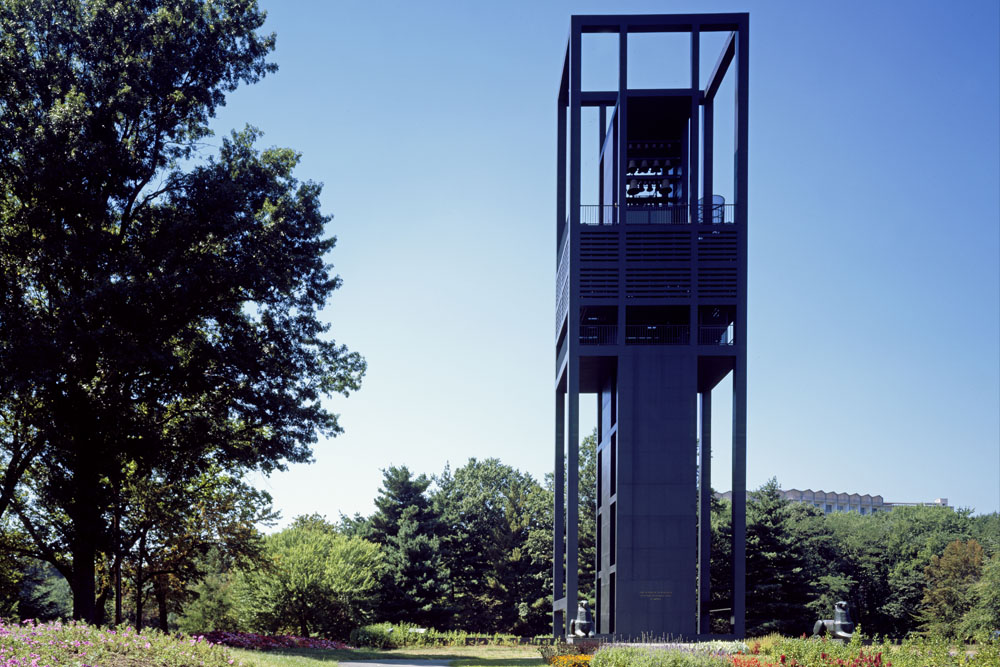The Netherlands Carillon will finally sound harmoniously after May 5
In 1951, the Dutch government decided to donate a carillon to the United States as a gesture of gratitude for the liberation and the Marshall aid. The instrument initially consisted of 49 bells and ended up in a modernist bell tower right next to Arlington National Cemetery with a view on the American capital of Washington D.C. In Bells for America, Diederik Oostdijk describes the arduous history of the Netherlands Carillon. The author is professor of English and American literature at the Vrije Universiteit in Amsterdam. We asked him several questions by e-mail about his book and the restoration of the instrument. The text was translated by Arnold Palthe.
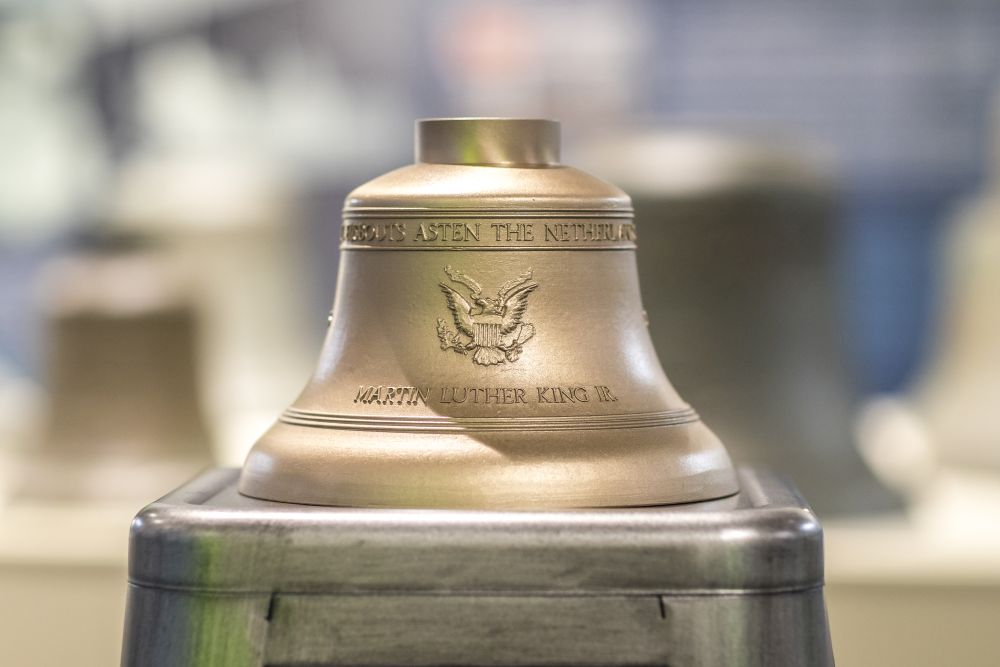 One of the three new bells, named after Martin Luther King. Photo: Rob Fritsen / SIRIS
One of the three new bells, named after Martin Luther King. Photo: Rob Fritsen / SIRIS
How did you get acquainted with the history of the carillon and what made you decide to write a book about it?
I was doing archival research for my dissertation in Washington D.C. in 1997, and staying with two American friends. On a foggy Sunday, they took me to Arlington National Cemetery to visit, among other things, John F. Kennedy's grave. On the way back to the car, we suddenly stumbled across the Netherlands Carillon. I had never heard of it and I was dumbstruck to see a Dutch monument at such a prominent spot in the monumental American landscape. In addition to English literature, I had also studied American Studies, so I proudly thought I knew everything these was to know about American history as well as of Dutch history. However, I had never heard about this piece of history yet, and I assumed this steel bell tower must have a special history because it stands on almost holy ground in the United States. A few years later, I was in the Nationaal Archief in The Hague, and discovered the archive of the Dutch embassy and the Department of Foreign Affairs. The striking history of the Netherlands Carillon unfolded itself right before my eyes.
What sources did you have at your disposal in order to write your book? Was it difficult to gather sufficient information?
No, it wasn’t that difficult. I had to do some digging, but eventually I was able to find much information. The Code Archief of Foreign Affairs was my most important source because it made clear how Ambassador Herman van Roijen was struggling with the Committee Bells for America, headed by the chairman of the Dutch parliament Rad Kortenhorst. There was hardly enough money for the bells of the carillon, and the Committee had not considered that it also had to donate a bell tower, which ended up costing nearly one million Dutch guilders. In addition to searching through Dutch archives, I was able to do archival research in Washington D.C., including at the National Archives and the archive of the Commission of Fine Arts which had approved the designs of the bell tower and determined the final destination of the Netherlands Carillon. Probably the most rewarding experience I had, though, was browsing through private archives of relatives who had contributed to the carillon. The archive of the Van Bergen bell-foundry, for instance, is being preserved by someone from the town of Heiligerlee who rescued the archive when that bell foundry went out of business. The daughter of the graphic artist Genia van der Grinter-Lücker, who designed most of the decorations for the bells, and the grandson of the engraver who finalized the designs, both had beautiful sketches and drawings at their homes which I was allowed to use for my book.
There have been many blunders in the realization of this present for the Americans. For instance, the little bell Queen Juliana was to present to President Truman got lost and the bells sounded out of tune. Do you have an explanation for so many things having gone wrong?
Yes, that story about the missing bell is hilarious, but Queen Juliana and the Dutch embassy covered up that incident well. The biggest blunder was made by the Committee Bells for America. It granted the production order for the bells to three competing foundries. They each had different procedures for casting bells, however. That was a recipe for disaster. In addition, the Committee asked three artists with different styles to cooperate with each other and a poet, Ben van Eijsselstein — who had been suspended after World War II for allegedly having collaborated with the Germans — to make the designs for the bells. So most of these errors were attributable to Kortenhorst and his committee. The irony of the story is that the Committee wanted all these parties to work together to create the image of the Netherlands as a harmonious country where everybody chimed in. Yet that forced unity resulted in a disharmonious carillon because taken together the bells sounded out of tune. Fortunately, this error has finally been repaired, as the bells were retuned last year by Royal Eijsbouts and will finally sound harmoniously.
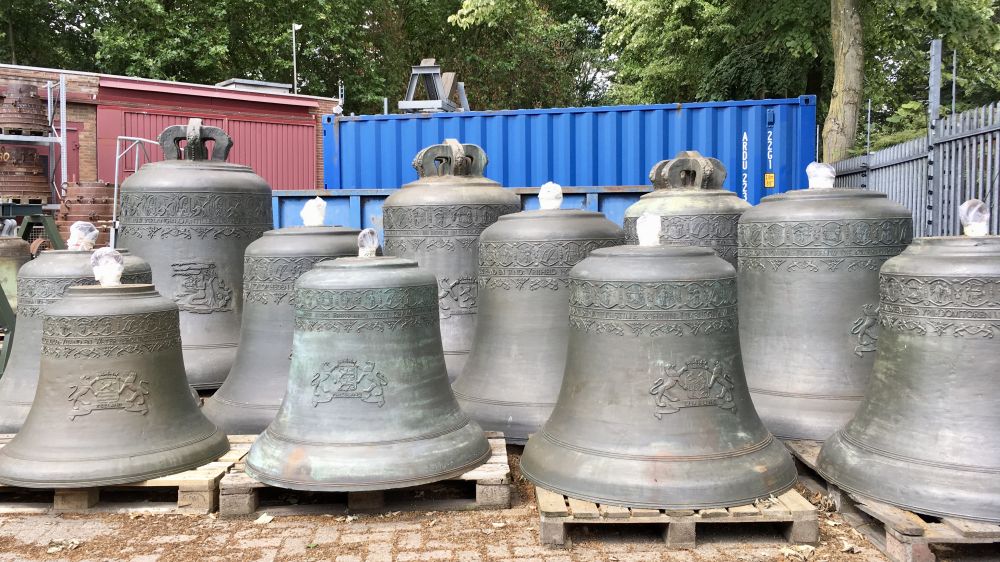 Bells of the Netherlands Carillon for retuning at Koninklijke Eijsbouts in Asten. Photo: Diederik Oostdijk
Bells of the Netherlands Carillon for retuning at Koninklijke Eijsbouts in Asten. Photo: Diederik Oostdijk
Nowadays in the Netherlands, Gerrit Rietveld is considered a celebrity in the field of architecture and building. How do you judge the decision of that time to remove him as architect of the tower due to his alleged Communist leanings? Who was or were responsible for this decision?
I think it was an unfortunate but necessary decision. It was taken by the minister of Foreign Affairs Joseph Luns after consultation with Ambassador Herman van Roijen. They had learned Rietveld had been denied a visa as he had tried to enter the U.S. via Mexico. A routine investigation was conducted, and it turned out that Rietveld had had Communist sympathies in his younger years. It was all rather innocent but the decision to have him design the bell tower was taken in 1956. At that time. Joseph McCarthy's witch hunt against Communists was in full swing. If the American press, or worse McCarthy himself, would have found out that an alleged Communist was to design a monument next to the holy ground of Arlington National Cemetery, it could have caused an international incident. Even though it is understandable that the Dutch took this decision, it is still a pity that Rietveld's design was never realized. It would have been the strangest bell tower ever. An American reviewer of Bells for America called it an “elaborate bat house,” and I think it is a fitting description. The current bell tower by architect Joost Boks is also a remarkable representation of Dutch design, by the way.
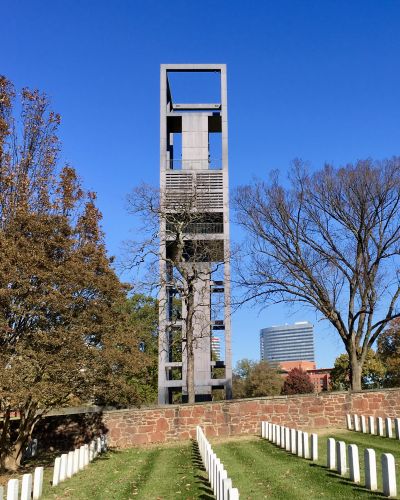 The Netherlands Carillon as seen from Arlington National Cemetery. Photo: Diederik Oostdijk
The Netherlands Carillon as seen from Arlington National Cemetery. Photo: Diederik Oostdijk
Meanwhile, 70 years have passed since The Netherlands donated the carillon to the U.S. The relationship between the two countries has changed over the years. What symbol does this monument stand for nowadays in your opinion? Does it still have any meaning for the future?
As I describe in my book, the Netherlands Carillon symbolizes the bond between the Netherlands and America over the years. Initially, the Netherlands were more obedient to the United States, and after that our country became more critical. When, for instance, the Vietnam war led to tensions between the two countries, the Dutch newspaper Telegraaf blamed the United States for the poor condition of the bell tower: “America lets our bell tower rot”. The Dutch government meanwhile tried to maintain cordial relations with the U.S. The dissonant bells and the dilapidated bell tower were the perfect metaphor for the disharmonious and unequal relationship. It is ironic, though, that it was during Donald Trump’s presidency that the Dutch embassy and the National Park Service decided to restore the Netherlands carillon to its original state once and for all and to see to it that the instrument will finally sound right. The Netherlands Carillon symbolizes the collaborative spirit of the 1940s and 1950s when the Western world wanted to cooperate with each other. The Europese Gemeenschap voor Kolen en Staal (E.G.K.S. or European Community for Coal and Steel), NATO and the UN were carillon-like institutions in which large and small countries/bells worked together in order to create a world in harmony. Trump's policy of 'America First' and his critical attitude about those international organizations made that history of unity subject for discussion. So I certainly envisage a future for the monument as a symbol of that endeavor towards unity, even if it will be accompanied by periods of dissonance.
Your book has been published in English as well in 2019. What are the reactions of the American readers? Is the history of the carillon really something Americans still dwell on?
The response to the book has been bigger in the Netherlands than in America. This is partly, I think, due to the television special of Andere Tijden but perhaps also because of the price of the book in the United States. Fortunately, there is a less expensive English version of the book on the market now, so hopefully that makes the bizarre history of the Netherlands Carillon more accessible to Americans. A number of reviews have been published, and the Washington Post paid attention to it as well, but it remains an unknown story for most Americans. I remain hopeful that Americans will come to appreciate this transnational monument more. As I indicated in the conclusion of Bells for America, the Netherlands Carillon resonates with other iconic American monuments, such as the U.S. Marine Corps War Memorial, the Lincoln Memorial, the Martin Luther King Memorial, the FDR Memorial and also with Arlington National Cemetery. The story about this unknown Dutch memorial deepens our knowledge of that symbolic and characteristic memorial landscape of Arlington and Washington D.C. Once I start telling the story, Americans are at least just as spellbound as Dutch people. Nonetheless, it remains a challenge to explain how unique this monument truly is.
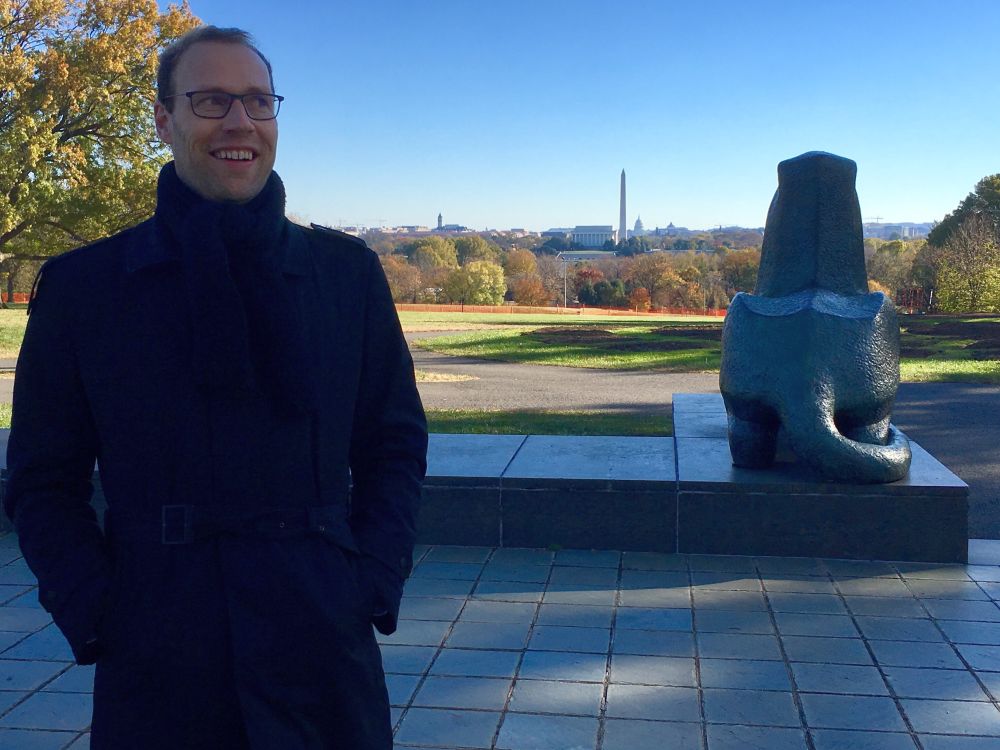 Diederik Oostdijk in front of the Netherlands Carillon overlooking Washington. Photo: Luc Rombouts
Diederik Oostdijk in front of the Netherlands Carillon overlooking Washington. Photo: Luc Rombouts
In the museum Klok & Peel a temporary display has been set up about the bells for America. What can we see there and is there still a chance to visit this exposition after the lockdown has been lifted?
The exhibit tells the entire story of the Netherlands Carillon from the first small bell up to the present restoration. Unfortunately, the bells which had been at the museum for a year, have had to be returned to the U.S. Yet there is a wooden replica of the bell tower, you can listen to audio and watch television recordings about the carillon, and you can get acquainted with the major players in the curious history of this carillon. All bells of the instrument represent all layers of the Dutch population, and it a selfie of how the Netherlands saw itself during the 50s, if you will. The exhibit in Asten tells the whole story. What is also special is that it is also explained how the three new bells for the carillon were cast by Royal Eijsbouts and how they retuned the 50 original bells. The exhibit is intended for everyone, for young kids as well as for senior citizens who may remember parts of this history. It is both a fun and educational experience, whether you are more into history or are technically minded.
During the past years the bells have been retuned and around May 5, three new bells will be presented to the Americans at the Dutch embassy in Washington D.C. How did the restoration proceed and what is the idea behind these new bells?
The restoration proceeded extremely well. The pandemic caused some delay, and the renovation of the bell tower was more expensive than planned, but this time the cooperation between the Americans and the Dutch occurred without the kinds the blunders from the past, which we discussed previously. On occasion of the 75th anniversary of the end of World War II, the Netherlands have also donated three additional bells: one enormous bass bell and two smaller ones. The largest one will be dedicated to George C. Marshall, the five-star general who is considered the architect of the Liberation, and who also gave his name to the massive economic aid package, the Marshall plan, from which the Netherlands and many other European countries benefitted after the war. The two others bear the names of Dr. Martin Luther King Jr. and Eleanor Roosevelt, another two inspirational Americans who fought for peace in the 20th century, each in their own way. Dr. Martin Luther King became the symbol of the struggle against racial segregation in the United States, and Eleanor Roosevelt helped draft the Declaration of Human Rights. Americans can admire the bells around May 5 at the Dutch embassy in Washington, and afterwards they will be hoisted into Boks' renovated bell tower. It has taken over sixty years, but with these new bells, the retuned Netherlands Carillon will finally sound harmoniously.
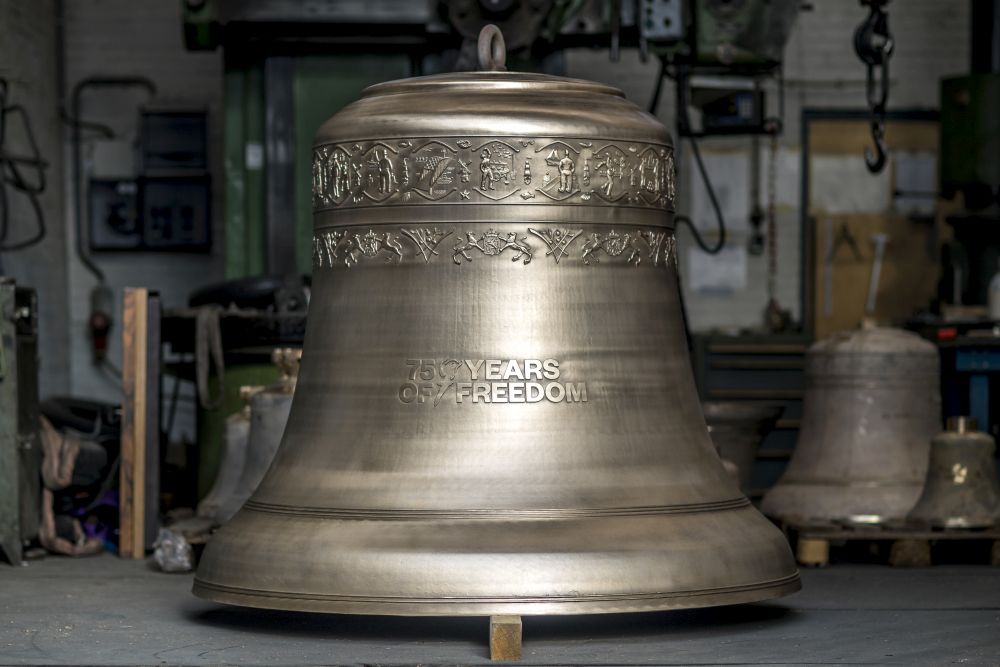 The great bell named after George Marshall. Photo: Rob Fritsen / SIRIS
The great bell named after George Marshall. Photo: Rob Fritsen / SIRIS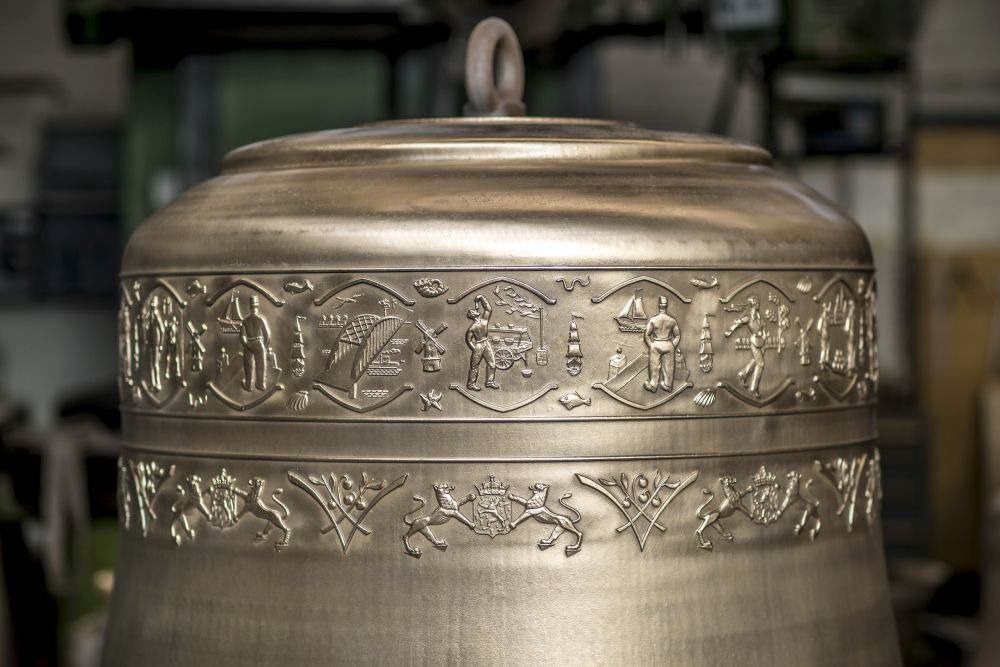 Edge ornaments on the Marshall bell. Photo: Rob Fritsen / SIRIS
Edge ornaments on the Marshall bell. Photo: Rob Fritsen / SIRIS
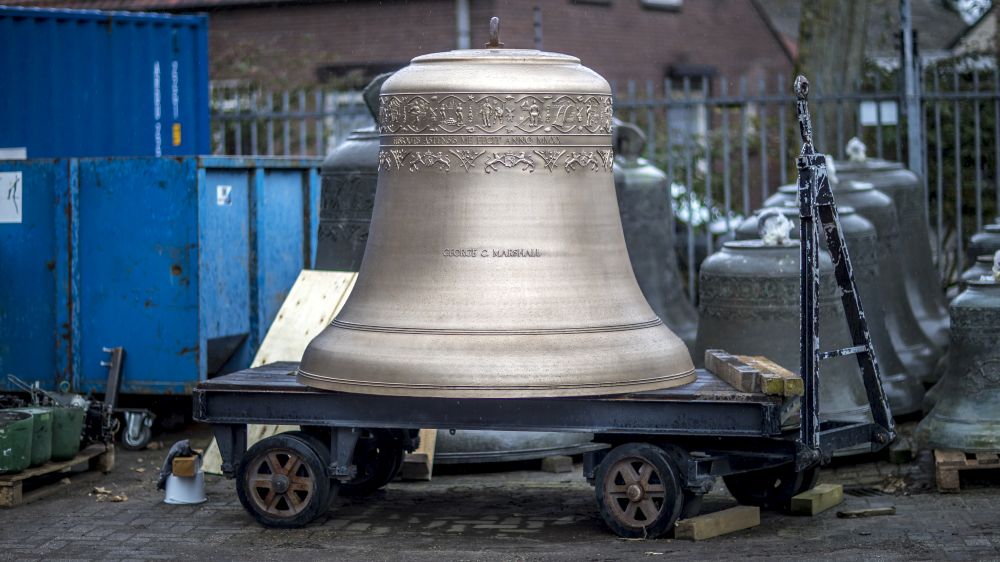 Photo: Rob Fritsen / SIRIS
Photo: Rob Fritsen / SIRIS
 One of the three new bells, named after Martin Luther King. Photo: Rob Fritsen / SIRIS
One of the three new bells, named after Martin Luther King. Photo: Rob Fritsen / SIRISHow did you get acquainted with the history of the carillon and what made you decide to write a book about it?
I was doing archival research for my dissertation in Washington D.C. in 1997, and staying with two American friends. On a foggy Sunday, they took me to Arlington National Cemetery to visit, among other things, John F. Kennedy's grave. On the way back to the car, we suddenly stumbled across the Netherlands Carillon. I had never heard of it and I was dumbstruck to see a Dutch monument at such a prominent spot in the monumental American landscape. In addition to English literature, I had also studied American Studies, so I proudly thought I knew everything these was to know about American history as well as of Dutch history. However, I had never heard about this piece of history yet, and I assumed this steel bell tower must have a special history because it stands on almost holy ground in the United States. A few years later, I was in the Nationaal Archief in The Hague, and discovered the archive of the Dutch embassy and the Department of Foreign Affairs. The striking history of the Netherlands Carillon unfolded itself right before my eyes.
What sources did you have at your disposal in order to write your book? Was it difficult to gather sufficient information?
No, it wasn’t that difficult. I had to do some digging, but eventually I was able to find much information. The Code Archief of Foreign Affairs was my most important source because it made clear how Ambassador Herman van Roijen was struggling with the Committee Bells for America, headed by the chairman of the Dutch parliament Rad Kortenhorst. There was hardly enough money for the bells of the carillon, and the Committee had not considered that it also had to donate a bell tower, which ended up costing nearly one million Dutch guilders. In addition to searching through Dutch archives, I was able to do archival research in Washington D.C., including at the National Archives and the archive of the Commission of Fine Arts which had approved the designs of the bell tower and determined the final destination of the Netherlands Carillon. Probably the most rewarding experience I had, though, was browsing through private archives of relatives who had contributed to the carillon. The archive of the Van Bergen bell-foundry, for instance, is being preserved by someone from the town of Heiligerlee who rescued the archive when that bell foundry went out of business. The daughter of the graphic artist Genia van der Grinter-Lücker, who designed most of the decorations for the bells, and the grandson of the engraver who finalized the designs, both had beautiful sketches and drawings at their homes which I was allowed to use for my book.
There have been many blunders in the realization of this present for the Americans. For instance, the little bell Queen Juliana was to present to President Truman got lost and the bells sounded out of tune. Do you have an explanation for so many things having gone wrong?
Yes, that story about the missing bell is hilarious, but Queen Juliana and the Dutch embassy covered up that incident well. The biggest blunder was made by the Committee Bells for America. It granted the production order for the bells to three competing foundries. They each had different procedures for casting bells, however. That was a recipe for disaster. In addition, the Committee asked three artists with different styles to cooperate with each other and a poet, Ben van Eijsselstein — who had been suspended after World War II for allegedly having collaborated with the Germans — to make the designs for the bells. So most of these errors were attributable to Kortenhorst and his committee. The irony of the story is that the Committee wanted all these parties to work together to create the image of the Netherlands as a harmonious country where everybody chimed in. Yet that forced unity resulted in a disharmonious carillon because taken together the bells sounded out of tune. Fortunately, this error has finally been repaired, as the bells were retuned last year by Royal Eijsbouts and will finally sound harmoniously.
 Bells of the Netherlands Carillon for retuning at Koninklijke Eijsbouts in Asten. Photo: Diederik Oostdijk
Bells of the Netherlands Carillon for retuning at Koninklijke Eijsbouts in Asten. Photo: Diederik OostdijkNowadays in the Netherlands, Gerrit Rietveld is considered a celebrity in the field of architecture and building. How do you judge the decision of that time to remove him as architect of the tower due to his alleged Communist leanings? Who was or were responsible for this decision?
I think it was an unfortunate but necessary decision. It was taken by the minister of Foreign Affairs Joseph Luns after consultation with Ambassador Herman van Roijen. They had learned Rietveld had been denied a visa as he had tried to enter the U.S. via Mexico. A routine investigation was conducted, and it turned out that Rietveld had had Communist sympathies in his younger years. It was all rather innocent but the decision to have him design the bell tower was taken in 1956. At that time. Joseph McCarthy's witch hunt against Communists was in full swing. If the American press, or worse McCarthy himself, would have found out that an alleged Communist was to design a monument next to the holy ground of Arlington National Cemetery, it could have caused an international incident. Even though it is understandable that the Dutch took this decision, it is still a pity that Rietveld's design was never realized. It would have been the strangest bell tower ever. An American reviewer of Bells for America called it an “elaborate bat house,” and I think it is a fitting description. The current bell tower by architect Joost Boks is also a remarkable representation of Dutch design, by the way.
 The Netherlands Carillon as seen from Arlington National Cemetery. Photo: Diederik Oostdijk
The Netherlands Carillon as seen from Arlington National Cemetery. Photo: Diederik OostdijkMeanwhile, 70 years have passed since The Netherlands donated the carillon to the U.S. The relationship between the two countries has changed over the years. What symbol does this monument stand for nowadays in your opinion? Does it still have any meaning for the future?
As I describe in my book, the Netherlands Carillon symbolizes the bond between the Netherlands and America over the years. Initially, the Netherlands were more obedient to the United States, and after that our country became more critical. When, for instance, the Vietnam war led to tensions between the two countries, the Dutch newspaper Telegraaf blamed the United States for the poor condition of the bell tower: “America lets our bell tower rot”. The Dutch government meanwhile tried to maintain cordial relations with the U.S. The dissonant bells and the dilapidated bell tower were the perfect metaphor for the disharmonious and unequal relationship. It is ironic, though, that it was during Donald Trump’s presidency that the Dutch embassy and the National Park Service decided to restore the Netherlands carillon to its original state once and for all and to see to it that the instrument will finally sound right. The Netherlands Carillon symbolizes the collaborative spirit of the 1940s and 1950s when the Western world wanted to cooperate with each other. The Europese Gemeenschap voor Kolen en Staal (E.G.K.S. or European Community for Coal and Steel), NATO and the UN were carillon-like institutions in which large and small countries/bells worked together in order to create a world in harmony. Trump's policy of 'America First' and his critical attitude about those international organizations made that history of unity subject for discussion. So I certainly envisage a future for the monument as a symbol of that endeavor towards unity, even if it will be accompanied by periods of dissonance.
Your book has been published in English as well in 2019. What are the reactions of the American readers? Is the history of the carillon really something Americans still dwell on?
The response to the book has been bigger in the Netherlands than in America. This is partly, I think, due to the television special of Andere Tijden but perhaps also because of the price of the book in the United States. Fortunately, there is a less expensive English version of the book on the market now, so hopefully that makes the bizarre history of the Netherlands Carillon more accessible to Americans. A number of reviews have been published, and the Washington Post paid attention to it as well, but it remains an unknown story for most Americans. I remain hopeful that Americans will come to appreciate this transnational monument more. As I indicated in the conclusion of Bells for America, the Netherlands Carillon resonates with other iconic American monuments, such as the U.S. Marine Corps War Memorial, the Lincoln Memorial, the Martin Luther King Memorial, the FDR Memorial and also with Arlington National Cemetery. The story about this unknown Dutch memorial deepens our knowledge of that symbolic and characteristic memorial landscape of Arlington and Washington D.C. Once I start telling the story, Americans are at least just as spellbound as Dutch people. Nonetheless, it remains a challenge to explain how unique this monument truly is.
 Diederik Oostdijk in front of the Netherlands Carillon overlooking Washington. Photo: Luc Rombouts
Diederik Oostdijk in front of the Netherlands Carillon overlooking Washington. Photo: Luc RomboutsIn the museum Klok & Peel a temporary display has been set up about the bells for America. What can we see there and is there still a chance to visit this exposition after the lockdown has been lifted?
The exhibit tells the entire story of the Netherlands Carillon from the first small bell up to the present restoration. Unfortunately, the bells which had been at the museum for a year, have had to be returned to the U.S. Yet there is a wooden replica of the bell tower, you can listen to audio and watch television recordings about the carillon, and you can get acquainted with the major players in the curious history of this carillon. All bells of the instrument represent all layers of the Dutch population, and it a selfie of how the Netherlands saw itself during the 50s, if you will. The exhibit in Asten tells the whole story. What is also special is that it is also explained how the three new bells for the carillon were cast by Royal Eijsbouts and how they retuned the 50 original bells. The exhibit is intended for everyone, for young kids as well as for senior citizens who may remember parts of this history. It is both a fun and educational experience, whether you are more into history or are technically minded.
During the past years the bells have been retuned and around May 5, three new bells will be presented to the Americans at the Dutch embassy in Washington D.C. How did the restoration proceed and what is the idea behind these new bells?
The restoration proceeded extremely well. The pandemic caused some delay, and the renovation of the bell tower was more expensive than planned, but this time the cooperation between the Americans and the Dutch occurred without the kinds the blunders from the past, which we discussed previously. On occasion of the 75th anniversary of the end of World War II, the Netherlands have also donated three additional bells: one enormous bass bell and two smaller ones. The largest one will be dedicated to George C. Marshall, the five-star general who is considered the architect of the Liberation, and who also gave his name to the massive economic aid package, the Marshall plan, from which the Netherlands and many other European countries benefitted after the war. The two others bear the names of Dr. Martin Luther King Jr. and Eleanor Roosevelt, another two inspirational Americans who fought for peace in the 20th century, each in their own way. Dr. Martin Luther King became the symbol of the struggle against racial segregation in the United States, and Eleanor Roosevelt helped draft the Declaration of Human Rights. Americans can admire the bells around May 5 at the Dutch embassy in Washington, and afterwards they will be hoisted into Boks' renovated bell tower. It has taken over sixty years, but with these new bells, the retuned Netherlands Carillon will finally sound harmoniously.
 The great bell named after George Marshall. Photo: Rob Fritsen / SIRIS
The great bell named after George Marshall. Photo: Rob Fritsen / SIRIS Edge ornaments on the Marshall bell. Photo: Rob Fritsen / SIRIS
Edge ornaments on the Marshall bell. Photo: Rob Fritsen / SIRIS Photo: Rob Fritsen / SIRIS
Photo: Rob Fritsen / SIRIS- Bells for America
- The Cold War, Modernism, and the Netherlands Carillon in Arlington
- ISBN: 9780271083773
- More information about this book

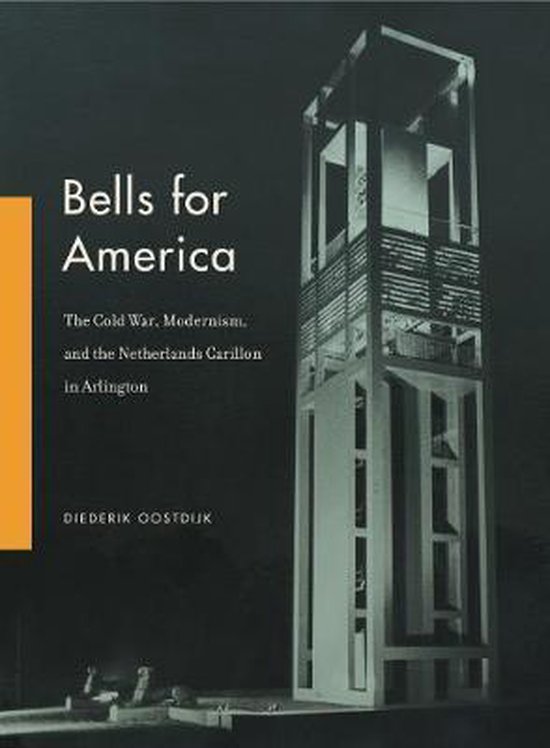
Used source(s)
- Source: Diederik Oostdijk / TracesOfWar.nl
- Published on: 25-04-2021 20:55:00
Related news
- 11-'24: Postal artifacts provide a vibrant testament to the experiences of the Dutch people during WWII
- 10-'24: DigitalBattlefieldTours unlocks military tactics to a wide audience
- 08-'24: Researching his father’s WWII history became a passion for Steve Snyder
- 08-'24: Who was the owner of the photo album from Dachau?
- 07-'24: The British people welcomed African American servicemen with open arms
Latest news
- 03-03: A WWII helmet returns home 80 years after having been lost at Remagen Bridge, Germany
- 16-02: Armin T. Wegner and his letter to Hitler
- 14-02: The hugely popular ‘Standing with Giants’ installation returns to the British Normandy Memorial
- 27-01: Russia focuses on Soviet victims of WW2 as officials not invited to Auschwitz ceremony
- 27-01: Oswald Kaduk, ‘Papa Kaduk’ or a monster??
- 12-'24: Christmas and New Year message from our volunteers
- 11-'24: New book: Righteous Behind Barbed Wire
- 11-'24: Postal artifacts provide a vibrant testament to the experiences of the Dutch people during WWII
- 10-'24: DigitalBattlefieldTours unlocks military tactics to a wide audience
- 10-'24: Lily Ebert, Holocaust Survivor, Author and TikTok Star, Dies at 100
